Modeling Spatiotemporal Dynamics and Driving Mechanisms of Ecosystem Services Bundles in Resource-Based Cities: Supply–Demand Mismatch in Xingtai, China
Abstract
1. Introduction
2. Materials and Methods
2.1. Study Area
2.2. Spatiotemporal Changes in Ecosystem Service Supply and Demand
2.2.1. Land Use Change
2.2.2. Modeling Ecosystem Services Supply and Demand
2.3. Analysis of Supply–Demand Balance Relationships
2.3.1. Supply–Demand Matching
2.3.2. Composite Supply–Demand Ratio
2.4. Ecosystem Service Supply–Demand Clusters
2.5. Driving Force Analysis
2.5.1. Redundancy Analysis
2.5.2. GTWR Model
2.6. Data Sources and Processing
3. Results
3.1. Land Use Changes
3.2. Ecosystem Service Supply and Demand Dynamics
3.2.1. Spatial–Temporal Characteristics of Ecosystem Service Supply
3.2.2. Spatial–Temporal Characteristics of Ecosystem Service Demand
3.3. Characteristics of Supply–Demand Relationships
3.3.1. Integrated Supply–Demand Ratio
3.3.2. Supply–Demand Matching Degree
3.4. Spatial Variation in Ecosystem Service Bundles
3.4.1. Bundle Classification
3.4.2. Analysis of Ecosystem Service Proportions in Each Bundle
3.5. Factors Influencing Ecosystem Service Supply–Demand Ratios
3.5.1. RDA
3.5.2. Analysis of GTWR Model
4. Discussion
4.1. The Dramatic Changes in Ecosystem Service Supply–Demand in Recent Decades
4.2. Ecosystem Service Supply–Demand Bundles Reflect the Spatial Heterogeneity of Ecological Functions
4.3. The Development and Ecological Protection of Resource-Based Cities Requires Coordinated Attention
4.4. Limitations
5. Conclusions
Author Contributions
Funding
Data Availability Statement
Conflicts of Interest
References
- Wang, Q.; Liu, M.; Tian, S.; Yuan, X.; Ma, Q.; Hao, H. Evaluation and Improvement Path of Ecosystem Health for Resource-Based City: A Case Study in China. Ecol. Indic. 2021, 128, 107852. [Google Scholar] [CrossRef]
- Zhu, S.; Huang, J.; Zhao, Y. Coupling Coordination Analysis of Ecosystem Services and Urban Development of Resource-Based Cities: A Case Study of Tangshan City. Ecol. Indic. 2022, 136, 108706. [Google Scholar] [CrossRef]
- Li, S.; Zhao, Y.; Xiao, W.; Yue, W.; Wu, T. Optimizing Ecological Security Pattern in the Coal Resource-Based City: A Case Study in Shuozhou City, China. Ecol. Indic. 2021, 130, 108026. [Google Scholar] [CrossRef]
- Costanza, R. Ecosystem Services: Multiple Classification Systems Are Needed. Biol. Conserv. 2008, 141, 350–352. [Google Scholar] [CrossRef]
- Shi, T.; Yang, S.; Zhang, W.; Zhou, Q. Coupling Coordination Degree Measurement and Spatiotemporal Heterogeneity between Economic Development and Ecological Environment—Empirical Evidence from Tropical and Subtropical Regions of China. J. Clean. Prod. 2020, 244, 118739. [Google Scholar] [CrossRef]
- Boyd, J.; Banzhaf, S. What Are Ecosystem Services? The Need for Standardized Environmental Accounting Units. Ecol. Econ. 2007, 63, 616–626. [Google Scholar] [CrossRef]
- Fan, S.; Yan, M.; Yu, L.; Chen, B.; Zhang, L. Integrating Ecosystem Service Supply–Demand and Ecological Risk Assessment for Urban Planning: A Case Study in Beijing, China. Ecol. Indic. 2024, 161, 111950. [Google Scholar] [CrossRef]
- You, C.; Qu, H.; Wang, C.; Feng, C.-C.; Guo, L. Trade-off and Synergistic of Ecosystem Services Supply and Demand Based on Socio-Ecological System (SES) in Typical Hilly Regions of South China. Ecol. Indic. 2024, 160, 111749. [Google Scholar] [CrossRef]
- Jones, L.; Norton, L.; Austin, Z.; Browne, A.L.; Donovan, D.; Emmett, B.A.; Grabowski, Z.J.; Howard, D.C.; Jones, J.P.G.; Kenter, J.O.; et al. Stocks and Flows of Natural and Human-Derived Capital in Ecosystem Services. Land Use Policy 2016, 52, 151–162. [Google Scholar] [CrossRef]
- Wei, J.; Chen, M.; Chu, C.; Zhao, C.; Xia, X.; Li, Y. Assessing Cultural Ecosystem Services Supply–Demand Balance of Urban Parks in the Context of Old and New Urban Districts. Ecol. Indic. 2024, 159, 111688. [Google Scholar] [CrossRef]
- Yang, M.; Zhao, X.; Wu, P.; Hu, P.; Gao, X. Quantification and Spatially Explicit Driving Forces of the Incoordination between Ecosystem Service Supply and Social Demand at a Regional Scale. Ecol. Indic. 2022, 137, 108764. [Google Scholar] [CrossRef]
- Zhang, J.; Guo, W.; Wang, Y.; Tang, Z.; Qi, L. Identifying the Regional Spatial Management of Ecosystem Services from a Supply and Demand Perspective: A Case Study of Danjiangkou Reservoir Area, China. Ecol. Indic. 2024, 158, 111421. [Google Scholar] [CrossRef]
- Villamagna, A.M.; Angermeier, P.L.; Bennett, E.M. Capacity, Pressure, Demand, and Flow: A Conceptual Framework for Analyzing Ecosystem Service Provision and Delivery. Ecol. Complex. 2013, 15, 114–121. [Google Scholar] [CrossRef]
- Shmelev, S.E.; Lefievre, N.; Saadi, N.; Shmeleva, I.A. Interdisciplinary Linkages among Sustainability Dimensions in the Context of European Cities and Regions Research. Sustainability 2023, 15, 14738. [Google Scholar] [CrossRef]
- Shmelev, S.E. Sustainable Cities Reimagined: Multidimensional Assessment and Smart Solutions; Routledge: Oxfordshire, UK, 2019; ISBN 978-1-000-62757-2. [Google Scholar]
- Shmelev, S.E.; Agbleze, L.; Spangenberg, J.H. Multidimensional Ecosystem Mapping: Towards a More Comprehensive Spatial Assessment of Nature’s Contributions to People in France. Sustainability 2023, 15, 7557. [Google Scholar] [CrossRef]
- Chen, S.; Chen, H.; Yang, R.; Ye, Y. Linking Social-Ecological Management and Ecosystem Service Bundles: Lessons from a Peri-Urban Agriculture Landscape. Land Use Policy 2023, 131, 106697. [Google Scholar] [CrossRef]
- Dou, H.; Li, X.; Li, S.; Dang, D.; Li, X.; Lyu, X.; Li, M.; Liu, S. Mapping Ecosystem Services Bundles for Analyzing Spatial Trade-Offs in Inner Mongolia, China. J. Clean. Prod. 2020, 256, 120444. [Google Scholar] [CrossRef]
- Salata, S.; Grillenzoni, C. A Spatial Evaluation of Multifunctional Ecosystem Service Networks Using Principal Component Analysis: A Case of Study in Turin, Italy. Ecol. Indic. 2021, 127, 107758. [Google Scholar] [CrossRef]
- Guan, X.; Xu, Y.; Meng, Y.; Xu, W.; Yan, D. Quantifying Multi-Dimensional Services of Water Ecosystems and Breakpoint-Based Spatial Radiation of Typical Regulating Services Considering the Hierarchical Clustering-Based Classification. J. Environ. Manag. 2024, 351, 119852. [Google Scholar] [CrossRef]
- Shen, J.; Li, S.; Liu, L.; Liang, Z.; Wang, Y.; Wang, H.; Wu, S. Uncovering the Relationships between Ecosystem Services and Social-Ecological Drivers at Different Spatial Scales in the Beijing-Tianjin-Hebei Region. J. Clean. Prod. 2021, 290, 125193. [Google Scholar] [CrossRef]
- Wu, F.; Liang, Y.; Liu, L.; Yin, Z.; Huang, J. Identifying Eco-Functional Zones on the Chinese Loess Plateau Using Ecosystem Service Bundles. Reg. Sustain. 2023, 4, 425–440. [Google Scholar] [CrossRef]
- Zhang, J.; Guo, W.; Cheng, C.; Tang, Z.; Qi, L. Trade-Offs and Driving Factors of Multiple Ecosystem Services and Bundles under Spatiotemporal Changes in the Danjiangkou Basin, China. Ecol. Indic. 2022, 144, 109550. [Google Scholar] [CrossRef]
- Li, Q.; Li, D.; Wang, J.; Wang, S.; Wang, R.; Fu, G.; Yuan, Y.; Zheng, Z. Spatial Heterogeneity of Ecosystem Service Bundles and the Driving Factors in the Beijing-Tianjin-Hebei Region. J. Clean. Prod. 2024, 479, 144006. [Google Scholar] [CrossRef]
- Tian, Y.; Zhang, Q.; Tao, J.; Zhang, Y.; Lin, J.; Bai, X. Use of Interpretable Machine Learning for Understanding Ecosystem Service Trade-Offs and Their Driving Mechanisms in Karst Peak-Cluster Depression Basin, China. Ecol. Indic. 2024, 166, 112474. [Google Scholar] [CrossRef]
- Ai, X.; Zheng, X.; Zhang, Y.; Liu, Y.; Ou, X.; Xia, C.; Liu, L. Climate and Land Use Changes Impact the Trajectories of Ecosystem Service Bundles in an Urban Agglomeration: Intricate Interaction Trends and Driver Identification under SSP-RCP Scenarios. Sci. Total Environ. 2024, 944, 173828. [Google Scholar] [CrossRef]
- Dong, W.; Wu, X.; Zhang, J.; Zhang, Y.; Dang, H.; Lü, Y.; Wang, C.; Guo, J. Spatiotemporal Heterogeneity and Driving Factors of Ecosystem Service Relationships and Bundles in a Typical Agropastoral Ecotone. Ecol. Indic. 2023, 156, 111074. [Google Scholar] [CrossRef]
- Zhang, S.; Huang, C.; Li, X.; Song, M. The Spatial–Temporal Evolution and Influencing Factors of the Coupling Coordination of New-Type Urbanization and Ecosystem Services Value in the Yellow River Basin. Ecol. Indic. 2024, 166, 112300. [Google Scholar] [CrossRef]
- Jiang, F.; Chen, B.; Li, P.; Jiang, J.; Zhang, Q.; Wang, J.; Deng, J. Spatio-Temporal Evolution and Influencing Factors of Synergizing the Reduction of Pollution and Carbon Emissions—Utilizing Multi-Source Remote Sensing Data and GTWR Model. Environ. Res. 2023, 229, 115775. [Google Scholar] [CrossRef]
- Hu, J.; Zhang, J.; Li, Y. Exploring the Spatial and Temporal Driving Mechanisms of Landscape Patterns on Habitat Quality in a City Undergoing Rapid Urbanization Based on GTWR and MGWR: The Case of Nanjing, China. Ecol. Indic. 2022, 143, 109333. [Google Scholar] [CrossRef]
- Jiang, S.; Feng, F.; Zhang, X.; Xu, C.; Jia, B.; Lafortezza, R. Ecological Transformation Is the Key to Improve Ecosystem Health for Resource-Exhausted Cities: A Case Study in China Based on Future Development Scenarios. Sci. Total Environ. 2024, 921, 171147. [Google Scholar] [CrossRef]
- Deng, F.; Zhu, S.; Guo, J.; Sun, X. Exploring the Quality of Ecosystem Services and the Segmental Impact of Influencing Factors in Resource-Based Cities. J. Environ. Manag. 2025, 375, 124411. [Google Scholar] [CrossRef]
- Hamel, P.; Guerry, A.D.; Polasky, S.; Han, B.; Douglass, J.A.; Hamann, M.; Janke, B.; Kuiper, J.J.; Levrel, H.; Liu, H.; et al. Mapping the Benefits of Nature in Cities with the InVEST Software. Npj Urban Sustain. 2021, 1, 25. [Google Scholar] [CrossRef]
- Su, X.; Shen, Y.; Xiao, Y.; Liu, Y.; Cheng, H.; Wan, L.; Zhou, S.; Yang, M.; Wang, Q.; Liu, G. Identifying Ecological Security Patterns Based on Ecosystem Services Is a Significative Practice for Sustainable Development in Southwest China. Front. Ecol. Evol. 2022, 9, 810204. [Google Scholar] [CrossRef]
- Zhang, L.; He, Z. Technical Note: An Empirical Algorithm Estimating Dry Deposition Velocity of Fine, Coarse and Giant Particles. Atmos. Chem. Phys. 2014, 14, 3729–3737. [Google Scholar] [CrossRef]
- Xiao, Y.; Wang, S.; Li, N.; Xie, G.; Lu, C.; Zhang, B.; Zhang, C. Atmospheric PM2.5 Removal by Green Spaces in Beijing. Resour. Sci. 2015, 37, 1149–1155. [Google Scholar]
- Kohonen, T. Self-Organizing Neural Projections. Neural Netw. 2006, 19, 723–733. [Google Scholar] [CrossRef]
- Shen, J.; Li, S.; Wang, H.; Wu, S.; Liang, Z.; Zhang, Y.; Wei, F.; Li, S.; Ma, L.; Wang, Y.; et al. Understanding the Spatial Relationships and Drivers of Ecosystem Service Supply-Demand Mismatches towards Spatially-Targeted Management of Social-Ecological System. J. Clean. Prod. 2023, 406, 136882. [Google Scholar] [CrossRef]
- Li, K.; Li, C.; Hu, Y.; Xiong, Z.; Wang, Y. Quantitative Estimation of the PM2.5 Removal Capacity and Influencing Factors of Urban Green Infrastructure. Sci. Total Environ. 2023, 867, 161476. [Google Scholar] [CrossRef]
- Li, Y.; Zhang, Y.; Wu, Q.; Xue, R.; Wang, X.; Si, M.; Zhang, Y. Greening the Concrete Jungle: Unveiling the Co-Mitigation of Greenspace Configuration on PM2.5 and Land Surface Temperature with Explanatory Machine Learning. Urban For. Urban Green. 2023, 88, 128086. [Google Scholar] [CrossRef]
- Lu, Z.; Li, W.; Yue, R. Investigation of the Long-Term Supply–Demand Relationships of Ecosystem Services at Multiple Scales under SSP–RCP Scenarios to Promote Ecological Sustainability in China’s Largest City Cluster. Sustain. Cities Soc. 2024, 104, 105295. [Google Scholar] [CrossRef]
- Fang, Y.; Meng, F.; Luo, M.; Sa, C.; Lei, J.; Bao, Y.; Chao, L. Disentangling the Natural and Anthropogenic Contributions to the Balance of Ecosystem Services in the Beijing-Tianjin-Hebei-Inner Mongolia Region. Ecol. Indic. 2024, 158, 111372. [Google Scholar] [CrossRef]
- Li, F.; Yin, X.; Shao, M. Natural and Anthropogenic Factors on China’s Ecosystem Services: Comparison and Spillover Effect Perspective. J. Environ. Manag. 2022, 324, 116064. [Google Scholar] [CrossRef]
- Kang, J.; Li, C.; Zhang, B.; Zhang, J.; Li, M.; Hu, Y. How Do Natural and Human Factors Influence Ecosystem Services Changing? A Case Study in Two Most Developed Regions of China. Ecol. Indic. 2023, 146, 109891. [Google Scholar] [CrossRef]
- Zhai, Y.; Zhai, G.; Yu, Z.; Lu, Z.; Chen, Y.; Liu, J. Coupling Coordination between Urbanization and Ecosystem Services Value in the Beijing-Tianjin-Hebei Urban Agglomeration. Sustain. Cities Soc. 2024, 113, 105715. [Google Scholar] [CrossRef]
- Bi, S.; Li, Z.; Chen, Y.; Zhang, Q.; Ye, T. Identification of Priority Conservation Areas in Beijing-Tianjin-Hebei Using Multi-Scenario Trade-Offs Based on Different Spatial Scales and Their Drivers. Ecol. Indic. 2024, 166, 112508. [Google Scholar] [CrossRef]
- Chen, H.; Li, Z.; Cui, X.; Zhao, M.; Shi, Y.; Lin, H.; Zhu, T. Analysis of Sustainable Spatial Structure of Cities under the Framework of “Economy-Society- Environment”: A Case Study Beijing-Tianjin-Hebei Urban Agglomeration. Ecol. Indic. 2025, 173, 113416. [Google Scholar] [CrossRef]
- Xu, W.; Jin, J.; Zhang, J.; Yuan, S.; Liu, Y.; Guan, T.; He, R.; Zhu, L. Coupling Coordination Degree, Interaction Relationship and Driving Mechanism of Water Resources Carrying Capacity of Beijing-Tianjin-Hebei Urban Agglomeration in China. J. Clean. Prod. 2025, 504, 145433. [Google Scholar] [CrossRef]
- Shmelev, S.E. Biodiversity Offset Schemes for Indonesia: Pro et Contra. Sustainability 2025, 17, 6283. [Google Scholar] [CrossRef]
- Wang, Z.; Liang, L.; Sun, Z.; Wang, X. Spatiotemporal Differentiation and the Factors Influencing Urbanization and Ecological Environment Synergistic Effects within the Beijing-Tianjin-Hebei Urban Agglomeration. J. Environ. Manag. 2019, 243, 227–239. [Google Scholar] [CrossRef]
- Wu, S.; Wang, D.; Yan, Z.; Wang, X.; Han, J. Coupling or Contradiction? The Spatiotemporal Relationship between Urbanization and Urban Park System Development in China. Ecol. Indic. 2023, 154, 110703. [Google Scholar] [CrossRef]

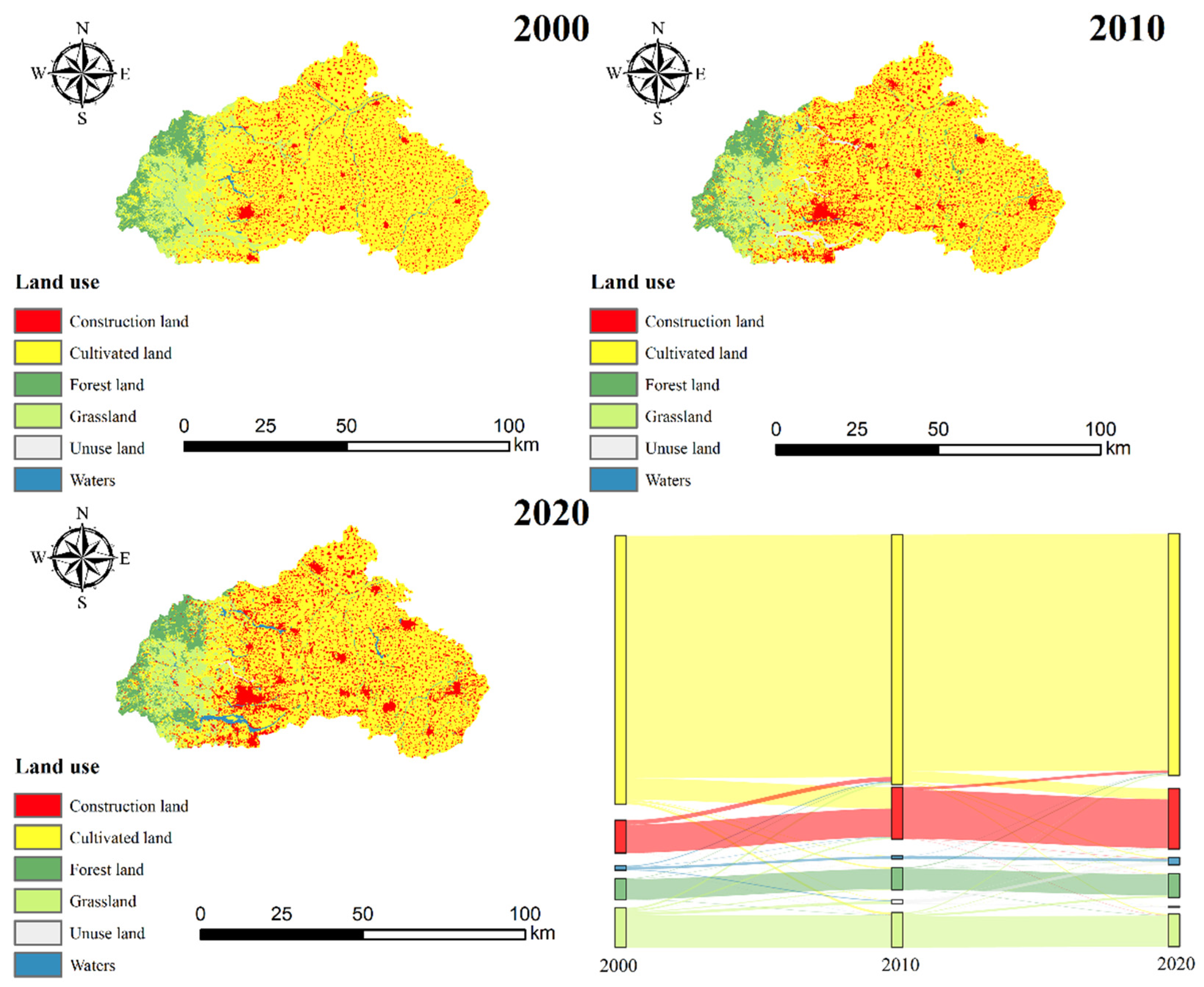

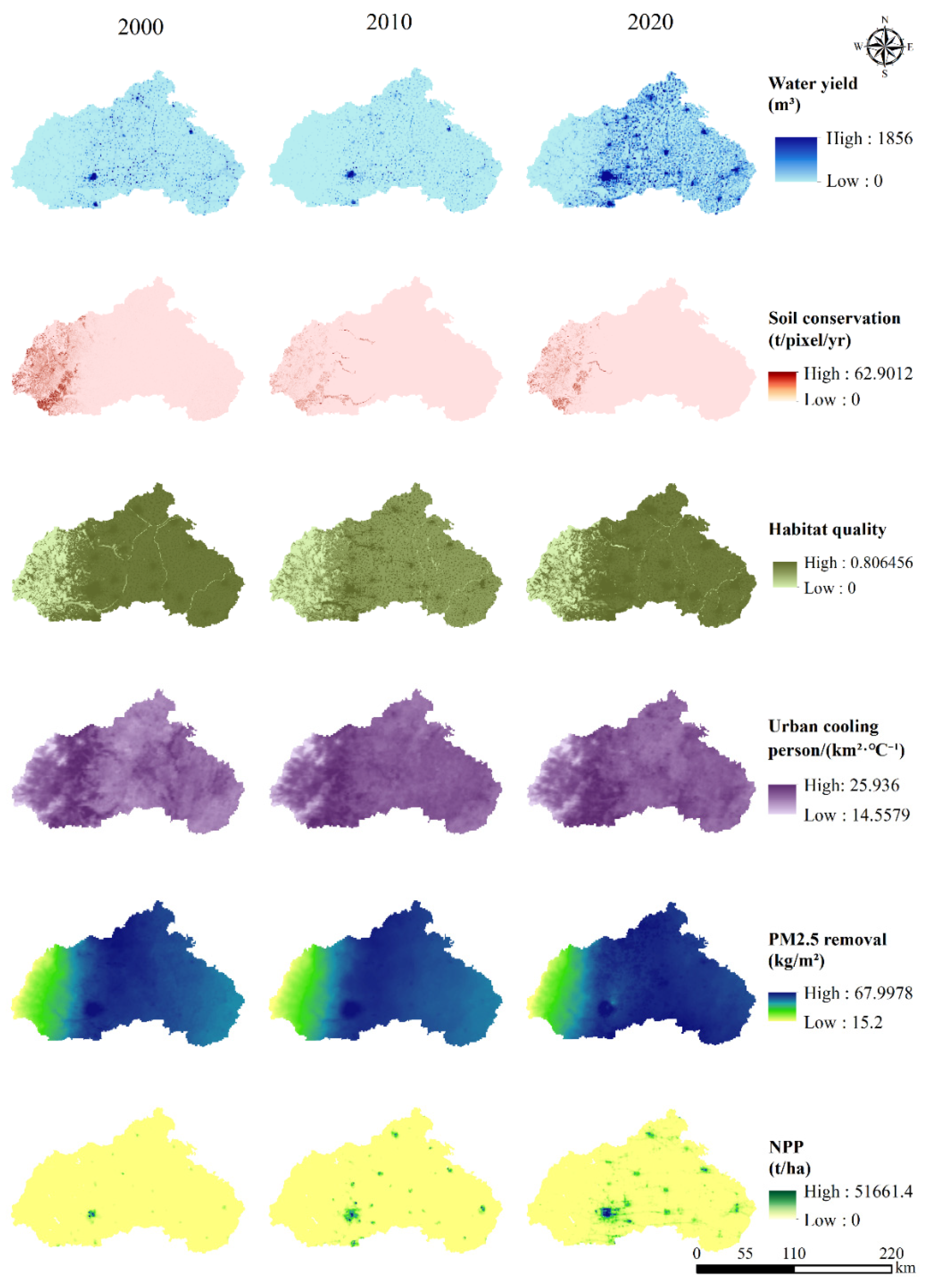


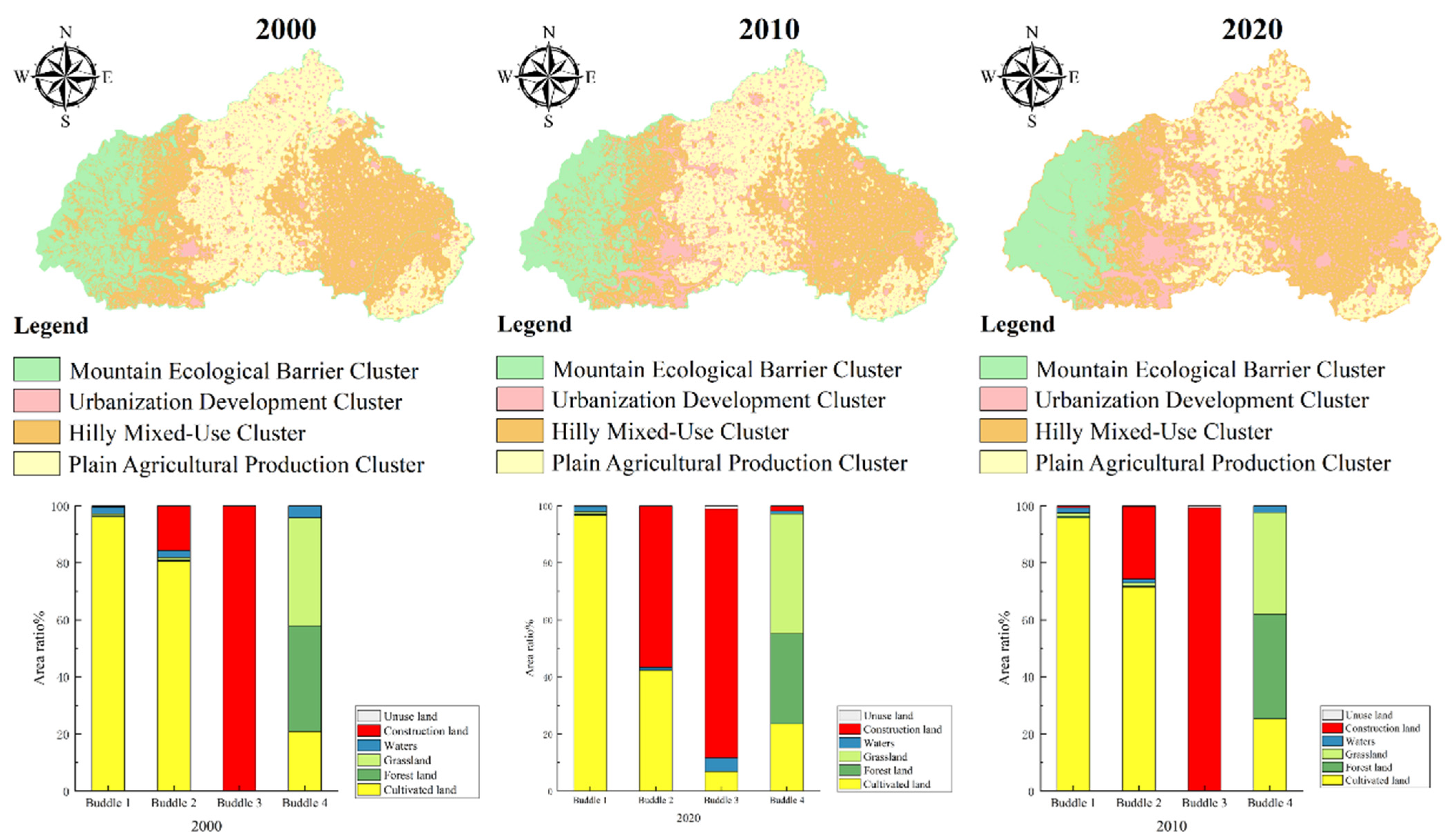
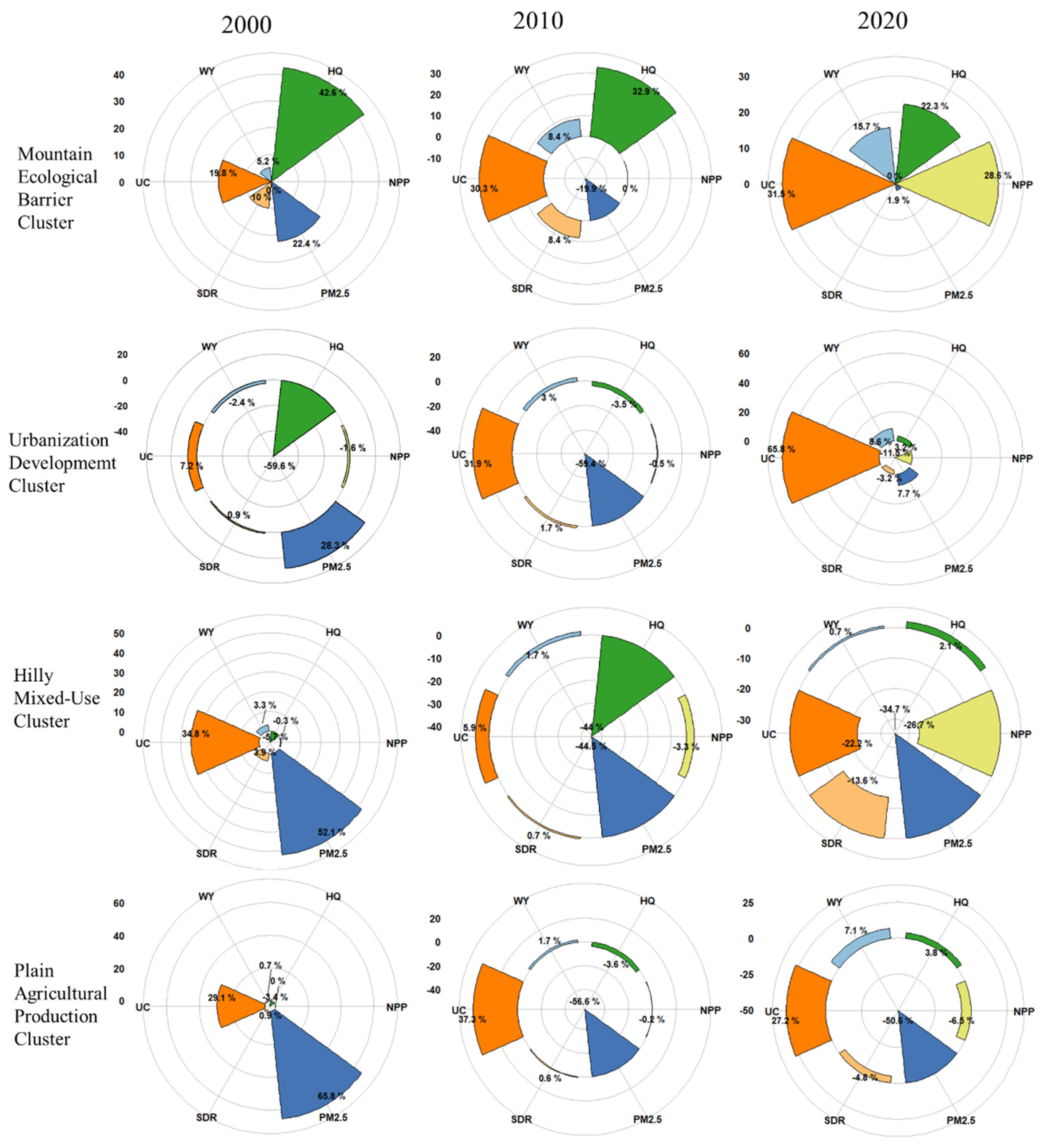
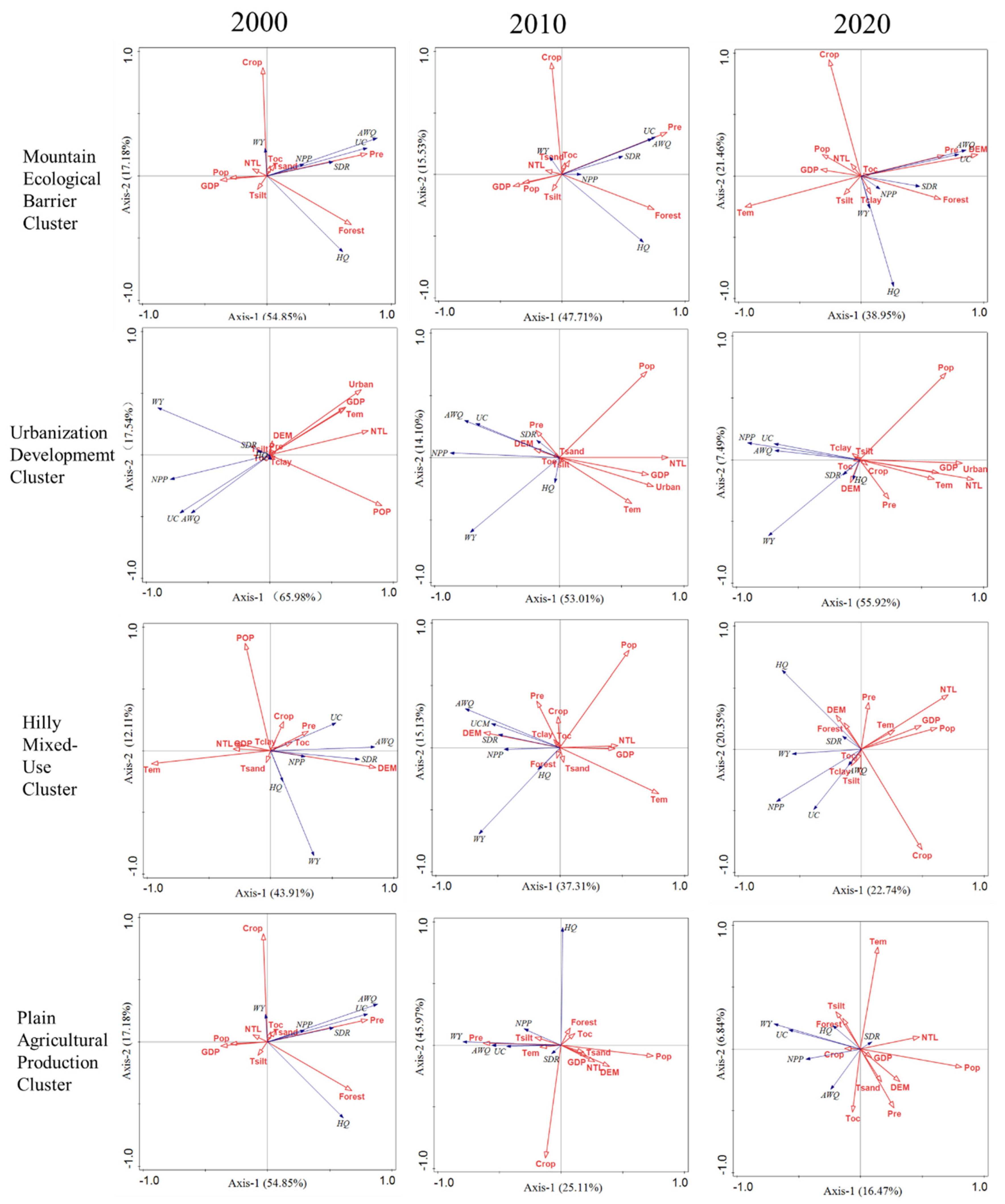

| ESs | Model Process | Parameters Description |
|---|---|---|
| WY | S: | = water production service supply (mm); = actual annual evapotranspiration (mm). = annual precipitation for raster cell x (mm). |
| D: | = the demand for water production services; , , , and represent industrial and domestic water use, agricultural water use, ecological water use, and other water use. | |
| SR | S: | SD = soil retention demand; RKLS = Potential Soil Erosion USLE = Actual Soil Erosion; R = Rainfall Erosivity Factor K = Soil Erodibility Factor; LS = Topographic Factor (slope length/steepness). C = Vegetation Management Factor; P = Anthropogenic Measures Factor. |
| D: | ||
| HQ | S: | = the level of provision of habitat quality services; Dxj = the level of stress experienced by raster x in land use type j; = the habitat suitability of land use type j. k = a scaling constant; z = a normalization constant. |
| D: | = the Habitat Quality Requirement Standard. S = the size of the study area (km2). | |
| UC | S: | HMi = the supply of heat island regulation services on image i. CCi = the cooling capacity index, shadowing, evapotranspiration, and albedo [33]. CCparki = the distance-weighted average of the CC values for the greenfield. dcool = the effective greenfield cooling distance. |
| D: | = the demand for heat island regulation; = the population density of the administrative unit; = the percentage of the population over 65 years of age in the administrative unit; T = the mean value of the inversion temperature [34]. | |
| PM2.5 | S: | = Annual PM2.5 Deposition; F = PM2.5 Deposition Flux; LAI = Annual Leaf Area Index; = PM2.5 Deposition Velocity; = Annual PM2.5 Concentration; V(x) = Air Purification Volume (grid x). C(x) = Grid Area, H = PM2.5 Distribution Height. |
| D: | = Required PM2.5 Reduction; = Annual PM2.5 Concentration. = PM2.5 “Excellent” Standard (35 μg/m3) [35,36]. | |
| NPP | S: | NPP(x,t) = Net Primary Productivity; APAR(x,t) = Absorbed Photosynthetically Active Radiation; ε(x,t) = Actual Light Use Efficiency; SOL(x,t) = Total Solar Radiation, FPAR(x,t) = Fraction of Absorbed PAR, Tε1(x,t); Tε2(x,t) = Temperature Stress Coefficients; Wε(x,t) = Water Stress Coefficient; εmax = Maximum Light Use Efficiency. |
| D: | CD = Carbon Sequestration Demand; = Nighttime Light Value (pixel x) = Total Regional Nighttime Light Value; C = Total Carbon Emissions. |
| Type | Driving Factors (Unit) | Abbreviation |
|---|---|---|
| Natural Factors | Annual Average Precipitation (mm) | Pre |
| Temperature | Tem | |
| Elevation (m) | DEM | |
| Soil Organic Matter (%) | Toc | |
| Clay Content | Tclay | |
| Silt Content | Tsilt | |
| Sand Content | Tsand | |
| Social Factors | GDP per Unit Area (10,000 yuan/km2) | GDP |
| Socioeconomic Activity Data (Nighttime Light) | NTL | |
| Population Density | Pop | |
| Proportion of Cultivated Land Area | Crop | |
| Proportion of Forest Area | Forest | |
| Proportion of Urban Area | Urban |
| Data Type | Data Resolution | Data Source |
|---|---|---|
| Land Use | 30 m | Resource and Environmental Science Data Platform (http://www.resdc.cn, accessed on 12 September 2025) |
| Elevation | 30 m | Earth Resources Data Cloud Platform—“Global 30 m SRTM Elevation DEM Data” (www.gis5g.com, accessed on 12 September 2025) |
| Soil Data | 1 km | Harmonized World Soil Database (HWSD) V1.2 |
| Precipitation and Evapotranspiration | 1 km | National Earth System Science Data Center (http://www.geodata.cn, accessed on 12 September 2025) |
| Temperature | 1 km | Earth Resources Data Cloud |
| Land Surface Temperature | 1 km | Resource and Environmental Science Data Platform |
| Nighttime Light | 1 km | Earth Observation Group—Payne Institute for Public Policy (https://www.mines.edu, accessed on 12 September 2025) |
| Population Density | 1 km | LandScan 1 km Global Population Distribution Raster Data |
| GDP and Energy Consumption | — | National Bureau of Statistics of China, China Energy Statistical Yearbook |
| Annual Average Leaf Area Index (LAI) | 1 km | Earth Resources Data Cloud—“China 1 km Monthly Average LAI Dataset (2000–2022)” (www.gis5g.com, accessed on 12 September 2025) |
| PM2.5 | 1 km | National Tibetan Plateau Data Center—“China High-resolution and High-quality PM2.5 Dataset (2000–2023)” (http://www.tpdc.ac.cn, accessed on 12 September 2025) |
| Population Age Structure, Water Use | County Level | County/City Statistical Yearbooks, Water Resources Bulletins |
| Year 2000 → Year 2020 ↓ | Cultivated Land | Forest Land | Grassland | Water Area | Construction Land | Unused Land | Total Outflow |
|---|---|---|---|---|---|---|---|
| Cultivated Land | 7955.334 | 40.7754 | 84.7161 | 71.4105 | 971.7075 | 3.8934 | 9127.8369 |
| Forest Land | 22.8645 | 667.1232 | 17.5824 | 0.8496 | 11.7468 | 0.0531 | 720.2196 |
| Grassland | 86.5269 | 98.6112 | 991.7424 | 87.6582 | 73.3383 | 0.3213 | 1338.1983 |
| Water Area | 30.3426 | 0.7029 | 2.0448 | 95.1615 | 10.359 | 17.0766 | 155.6874 |
| Construction Land | 125.9064 | 0.5391 | 0.9846 | 2.0502 | 985.9302 | 0.099 | 1115.5095 |
| Unused Land | 0 | 0 | 0 | 0 | 0 | 0 | 0 |
| Total Inflow | 8220.9744 | 807.7518 | 1097.0703 | 257.13 | 2053.0818 | 21.4434 | 12457.4517 |
| Net Change | −906.8625 | 87.5322 | −241.128 | 101.4426 | 937.5723 | 21.4434 | — |
| Model | AICc | R2 | R2 Adjusted |
|---|---|---|---|
| OLS | 1906.4 | 0.314 | - |
| GWR | 1206.785 | 0.515 | 0.509 |
| GTWR | 902.411 | 0.642 | 0.636 |
Disclaimer/Publisher’s Note: The statements, opinions and data contained in all publications are solely those of the individual author(s) and contributor(s) and not of MDPI and/or the editor(s). MDPI and/or the editor(s) disclaim responsibility for any injury to people or property resulting from any ideas, methods, instructions or products referred to in the content. |
© 2025 by the authors. Licensee MDPI, Basel, Switzerland. This article is an open access article distributed under the terms and conditions of the Creative Commons Attribution (CC BY) license (https://creativecommons.org/licenses/by/4.0/).
Share and Cite
Wang, R.; Luo, K.; He, Q.; Xia, L.; Wang, Z.; Yang, C.; Xie, M. Modeling Spatiotemporal Dynamics and Driving Mechanisms of Ecosystem Services Bundles in Resource-Based Cities: Supply–Demand Mismatch in Xingtai, China. Land 2025, 14, 2270. https://doi.org/10.3390/land14112270
Wang R, Luo K, He Q, Xia L, Wang Z, Yang C, Xie M. Modeling Spatiotemporal Dynamics and Driving Mechanisms of Ecosystem Services Bundles in Resource-Based Cities: Supply–Demand Mismatch in Xingtai, China. Land. 2025; 14(11):2270. https://doi.org/10.3390/land14112270
Chicago/Turabian StyleWang, Ruohan, Keyu Luo, Qiuhua He, Le Xia, Zhenyu Wang, Chen Yang, and Miaomiao Xie. 2025. "Modeling Spatiotemporal Dynamics and Driving Mechanisms of Ecosystem Services Bundles in Resource-Based Cities: Supply–Demand Mismatch in Xingtai, China" Land 14, no. 11: 2270. https://doi.org/10.3390/land14112270
APA StyleWang, R., Luo, K., He, Q., Xia, L., Wang, Z., Yang, C., & Xie, M. (2025). Modeling Spatiotemporal Dynamics and Driving Mechanisms of Ecosystem Services Bundles in Resource-Based Cities: Supply–Demand Mismatch in Xingtai, China. Land, 14(11), 2270. https://doi.org/10.3390/land14112270






